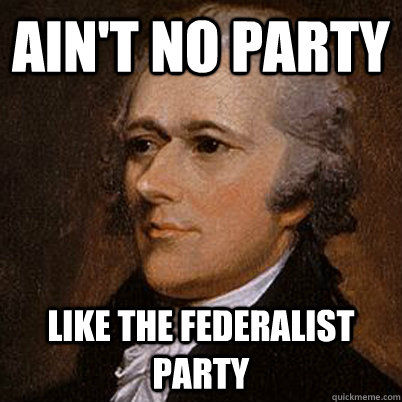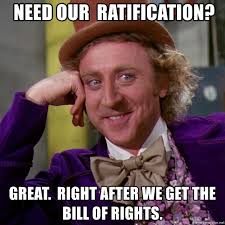Fatima Raja
Riya Patel
AP US Government 👩🏾⚖️
240 resourcesSee Units
Required Founding Documents for APGOPO
If you’ve listened to Lin Manuel Miranda’s musical Hamilton: An American Story, you probably ended up learning a lot about American history without meaning to (Think: HAMILTON WROTE THE OTHER 51 😭).
So, yeah, Alexander Hamilton did write the vast majority of the Federalist Papers (aka the papers that argued for a strong federal government and the ratification of the U.S. Constitution).
But, we’re going to be talking about waaay more than that: the Declaration of Independence, the Articles of Confederation, the Constitution and Bill of Rights, the Federalist Papers, Brutus 1, and the Letter from Birmingham Jail.
Let’s get into it!
Declaration of Independence
Thomas Jefferson wrote the Declaration of Independence to explain why the colonies were breaking away from Great Britain.
He explained that Americans deserved the rights to life, liberty, and the pursuit of happiness (aka their unalienable rights). He said that when a government violated those rights it was imperative for the people to overthrow that government and put a just government in its place.
Jefferson then listed a bunch of ways that Great Britain and King George the Third had wronged the colonists. He included things like destroying their property and taxing them without representation. 😤
At the very bottom, delegates from the colonies signed their names to signify their support of the document.
Image Courtesy of MEME

This better not be y’all before the AP exam 👀.
Articles of Confederation
The delegates to the colonies realized that they, um, kinda needed a government to, ummm, ya know, govern, during the Revolutionary War.
So, at the 2nd Continental Congress they wrote and ratified the Articles of Confederation to give them a governance structure. It’s important to keep in mind that they were written at a time where the colonies were rebelling against a powerful, tyrannical government.
Congress could do a bunch of things under the Articles: regulate foreign affairs, war, and the postal service, control Indian affairs, borrow money, determine the value of coin, and issue bills of credit.
That was cool and all, but there were also a whole lot of things that Congress couldn’t do. The flaws became much more evident after the Revolutionary War was over. One of the most important was taxing states. This was problematic because states also didn’t want to impose taxes and give money to the federal government. 🙄
That meant Congress couldn’t pay back wartime debt and made countries reluctant to lend money to America after the war. It also led to some states having huge amounts of debt and others having thriving economies.
Congress also couldn’t draft troops, impose tariffs, or regulate interstate commerce.
States were also being super annoying and literally started imposing tariffs ON EACH OTHER. Like, they’re literally on the same team, right??
Congress really couldn’t do anything about any of that because it took 9 of the 13 states to pass any laws or amendments, so nothing really got done.
But, it worked during the Revolutionary War, so that’s fun, right? 🤷🏽♀️
Image Courtesy of Meme Generator

Federalist 10
James Madison titled this bad boy “The Utility of the Union as a Safeguard Against Domestic Faction and Insurrection," but everyone calls it Federalist 10 to save time.
Madison explained that factions (groups of people, specifically political parties) are inherent to human nature. They can be things like class, or occupation, or anything else.
He worried about them because they could incite violence and political instability. Remember, America was waaay smaller back then! It wouldn’t take 100 million people to cause trouble, which would be really bad because people wouldn’t trust the government to keep the peace.
Soooo, Madison was like “Well, this is not fun or fresh. I gotta make sure this doesn’t happen.”
He thought about it and realized some people might think they couldn’t stop factions without violating liberties. That’s why he (iconically) wrote destroying liberty is a "cure worse than the disease itself." Ya know, because the entire point of the American Revolution was guaranteeing liberty.
That’s why Madison argued for a representative government, (aka the House of Representatives) to ensure that the rights of the minority were maintained. Because the alternative, which was a popular government where pretty much every person could vote to make legislative decisions, was more conducive to factionalism.
Representative government would also cause factional passion to be spread across different states (because of sectionalism) and not be concentrated in one area, which would lead to chaos. Elected officials could also be voted out, making them more likely to work to represent common interests rather than their own potentially polarized opinions.
Federalist 51
This was another hit from J. Mad, and he called it “The Structure of the Government Must Furnish the Proper Checks and Balances Between the Different Departments," so, yeah, we’re calling it Federalist 51.
He worried that one branch would dominate the others, which would obviously lead to tyranny. He didn’t want a government dominated by the majority and wanted to protect minority opinions.
So, he said a division of power among branches was necessary and that power would be further divided among state governments.
He said that the legislative branch would be the true voice of the people, as officeholders would be elected and said that power would be divided internally between two chambers (ex. A bill has to pass in the House and the Senate to become law).
Image Courtesy of Meme
Brutus 1
There were also some people that opposed ratifying the Constitution: the anti-Federalists. One of them wrote Brutus 1.
He argued that the Constitution would turn the “league of friendship” that the 13 states had into a government that gave ultimate authority to the federal government, which would lead to tyranny.
It argued that federal power was bad and that the Constitution gives too much power to the federal government. For example, the Necessary and Proper Clause would allow the federal government to make any laws, and the Supremacy Clause that said that federal law supersedes state law would give states no power to disagree with the federal government.
It’s important to remember that America was expanding in this time period.
That’s why Brutus said a representative democracy would only create an elite group of people that lead the country because they would concentrate power. He said that representative democracy wouldn’t work in a large country, and people’s views would be inaccurately represented.
Federalist 70
We finally get to talk about A. Ham, our main man. Alexander Hamilton wrote Federalist 70 to advocate for an “energetic executive.”
Some people were arguing that having a council of 3 executives would be the best course of action.
Alexander Hamilton disagreed. He said that 3 executives would naturally argue and their “bitter dissensions” would cause people to lose respect for the executive branch and weaken its authority in the eyes of the people.
A single executive would also be more closely scrutinized by the people, and it would be easier to watch one person than a group of people.
Image Courtesy of Quickmeme

Federalist 78
A lot of people worried that having a branch composed of people that were not elected and couldn’t be voted out of office was super dangerous.
Alexander Hamilton talked about the judiciary branch in this Paper to allay their concerns.
He began by explaining that the judiciary branch didn’t have "influence over either the sword or the purse” (which means it couldn’t enforce laws, like the President, or take away funding, like Congress).
This meant it was kinda just there. The judicial branch would have to rely on Congress and the President to have any real power, and they could just choose to ignore its rulings.
He also talked about judicial review and why it was important. Hamilton said that judicial review was critical to preventing Congress from abusing its power and that laws being reviewed by the courts for constitutionality would make sure that the legislative branch would be checked.
The Constitution and Bill of Rights
The United States Constitution was ratified after Federalists agreed to add a Bill of Rights to prevent the federal government from infringing upon peoples’ rights.
The Constitution established that the federal government would be composed of three branches: Congress (legislative), the President and bureaucracy (executive), and the Courts (judiciary). These three branches would have the ability to check each others’ powers to prevent any one branch from becoming too powerful. For example, the president could veto a law passed by Congress.
The Constitution also had amendments added to it. The first 10 are called the Bill of Rights.
The Bill of Rights guarantees Americans certain rights that cannot be taken away or violated by the federal government. For example, the First Amendment guarantees people the right to free speech.
Thus, the federal government that America has today was established.
Image Courtesy of Meme Generator

Letter from Birmingham Jail
Dr. Martin Luther King Jr. was sent to jail for protesting segregation in Birmingham. That’s where he wrote his “Letter from Birmingham City Jail.”
He explains that direct action (peaceful protest) is necessary to force white people to confront racism and that it is direct action that would open up an opportunity for dialogue. He also mentions that civil disobedience is a patriotic response to laws that are unjust.
King goes on to discuss his disappointment in “white moderates” who claim to oppose racism but also reject any direct action. He says that they are more detrimental to the cause of equality than the KKK because they passively allow injustice to continue. He also criticizes the white leadership of churches for upholding the status quo rather than advocating for equality as it once had.
King ends by saying that African Americans will achieve equality, that their fight for freedom and desegregation will be successful.
Conclusion
That’s all the important stuff y’all need to know about the foundational documents for US Government.
Happy politicking!
Browse Study Guides By Unit
🏛Unit 1 – Foundations of American Democracy
⚖️Unit 2 – Branches of Government
✊🏽Unit 3 – Civil Liberties & Civil Rights
🐘Unit 4 – American Political Ideologies & Beliefs
🗳Unit 5 – Political Participation
🤔Exam Skills

Fiveable
Resources
© 2025 Fiveable Inc. All rights reserved.